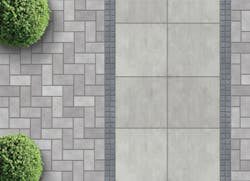A Look at Today’s Pervious, Porous, and Permeable Pavers
Sinking wheels, muddy feet, lame horses and livestock, trade goods ruined—these might have been just a few of the reasons why humans developed pavers thousands of years ago as an answer to a better surface. While the Romans come to mind as the first to build paver-based roads around 156 AD, they had adopted the process from the North African Carthaginians of Tunisia, where historians estimate pavers were already old news, in use for at least 500 years prior. In fact, many of these first stone paver roads can still be seen today.
Fast-forward a few thousand years and permeable pavers have changed little; they are sometimes square but most often rectangular, usually twice as long as wide. But their manufacture has leaped into the 21st century by adopting new technology, engineering, and materials.
Sinking wheels, muddy feet, lame horses and livestock, trade goods ruined—these might have been just a few of the reasons why humans developed pavers thousands of years ago as an answer to a better surface. While the Romans come to mind as the first to build paver-based roads around 156 AD, they had adopted the process from the North African Carthaginians of Tunisia, where historians estimate pavers were already old news, in use for at least 500 years prior. In fact, many of these first stone paver roads can still be seen today. Fast-forward a few thousand years and permeable pavers have changed little; they are sometimes square but most often rectangular, usually twice as long as wide. But their manufacture has leaped into the 21st century by adopting new technology, engineering, and materials. [text_ad] Today’s pervious, permeable, and porous pavers truly meet the message famed architect Louis Sullivan preached: “Form follows function.” What could be better than an aesthetically pleasing product that can also function as an onsite stormwater and erosion control manager? Today’s High-Tech Pavers Mark Walker, director of development for Kuert Concrete Inc. in South Bend, IN, the Midwest distributor of Xeripave, explains how pavers now fall under “one of the three Ps”: “First, there are pervious pavers, and we compare those to permeable and porous pavers; all have their own distinct characteristics, but the difference between them is how stormwater infiltration is managed by the paver.” Walker says water actually flows through the Xeripave paver itself to the underlying stone and soil layers, eventually replenishing the area’s aquifer. He adds that minimizing stormwater runoff has a direct effect on minimizing downhill erosion issues, and it’s a perfect solution where stormwater management—along with erosion control—needs to be addressed. Because the pavers do such a great job of infiltrating surface water, only 15–18% of the overall surface of any given project requires Xeripave. This allows the use of other surface materials such as asphalt or concrete, thus minimizing project costs. “These perform the same function as traditional hardscape products, but as they are totally pervious, there is never any standing water. In fact, ice can rarely form because water doesn’t sit on the surface, making it perfect for pedestrian walkways and parking areas.” He says the pavers have UV resistance to increase product longevity. Although Xeripave pavers have been used extensively for walkways in front of public buildings such as railway stations, hospitals, and banks, Walker is very enthusiastic about the project completed by the city of Anderson, IN. He describes the novel use of the pavers as “like nothing I’ve ever seen in my travels around the country, and one that should be commended not only for its ingenuity, but for its contribution toward accelerating cost-effective green stormwater infrastructure.”Today’s pervious, permeable, and porous pavers truly meet the message famed architect Louis Sullivan preached: “Form follows function.” What could be better than an aesthetically pleasing product that can also function as an onsite stormwater and erosion control manager?
Today’s High-Tech Pavers
Mark Walker, director of development for Kuert Concrete Inc. in South Bend, IN, the Midwest distributor of Xeripave, explains how pavers now fall under “one of the three Ps”: “First, there are pervious pavers, and we compare those to permeable and porous pavers; all have their own distinct characteristics, but the difference between them is how stormwater infiltration is managed by the paver.”
Walker says water actually flows through the Xeripave paver itself to the underlying stone and soil layers, eventually replenishing the area’s aquifer. He adds that minimizing stormwater runoff has a direct effect on minimizing downhill erosion issues, and it’s a perfect solution where stormwater management—along with erosion control—needs to be addressed.
Because the pavers do such a great job of infiltrating surface water, only 15–18% of the overall surface of any given project requires Xeripave. This allows the use of other surface materials such as asphalt or concrete, thus minimizing project costs.
“These perform the same function as traditional hardscape products, but as they are totally pervious, there is never any standing water. In fact, ice can rarely form because water doesn’t sit on the surface, making it perfect for pedestrian walkways and parking areas.” He says the pavers have UV resistance to increase product longevity.
Although Xeripave pavers have been used extensively for walkways in front of public buildings such as railway stations, hospitals, and banks, Walker is very enthusiastic about the project completed by the city of Anderson, IN. He describes the novel use of the pavers as “like nothing I’ve ever seen in my travels around the country, and one that should be commended not only for its ingenuity, but for its contribution toward accelerating cost-effective green stormwater infrastructure.”


